The second page of Google search results is like a mystical and haunted space that almost no one has set foot on. And you certainly don’t want your website to get stuck there permanently. That is why following WordPress SEO best practices will help you rank higher on search engine result pages (SERP) and avoid landing on that spooky second page.
Here is what we’ll guide you through in this article:
Why is SEO for WordPress important?
20 fatal tips to achieve high rankings in 2021:
WordPress SEO Basics
1) www vs non-www domain
2) Choosing a reliable hosting provider
3) Install an SEO friendly template
4) Add your site to Google Search Console
5) Add XML Sitemaps in WordPress
6) Force Crawl
WordPress SEO Plugins and Services
7) Install Yoast SEO Plugin
8) Use 10Web’s SEO services
WordPress SEO Best Practices
9) Keyword Research
10) Internal Linking
11) External Linking
12) Taxonomy: proper use of categories and tags
13) Title tags and Meta descriptions
14) Schema markup
15) Get into the Google Knowledge Graph
16) WordPress Comments
17) Create an Evergreen content
18) Have a Blog Section
19) Use Google Analytics
Security for WordPress SEO
Security Basics
20) Using SSL/HTTPS for your WordPress SEO
Now, let’s have a look.
What is SEO for WordPress?
SEO (search engine optimization) refers to the practices meant to rank your website higher in the search engines (Google, Yandex, Bing…). SEO is important, because the higher you rank on search engines the more website traffic you get, which means that you get organic traffic growth.
According to HubSpot’s report, 61% of marketers agreed that SEO and the growth of their organic presence is a priority in their inbound marketing. In addition, Zero Limit Web has shown that more than two-thirds of all clicks (67.60%) go to the first five organic results of the first page. So, being at the top of search results can really help you grow your business!
Now you might have wondered:
Is WordPress good for SEO?
Fortunately for WP users, WordPress is known to be super SEO friendly, as it has many useful features already included in its code, but there are still some things you need to do by yourself to ensure that your WordPress SEO works on a high level.
Why is SEO for WP important?
According to JoelHouse, 93% of your web traffic comes from search engines. Moreover, if SEO practices are kept, you’ll generally get a higher conversion rate than with traditional marketing strategies. So, if you want your website to grow, you certainly need to pay attention to your website’s SEO, and WordPress has a lot of good tools that help you to do so. For instance, it focuses on user experience, which means its themes and plugins are designed to attract and keep your visitors, and it also makes it super easy to manage your metadata.
But with all of these advantages, you still need to know more SEO rules if you want to outgrow your competitors. Take a look at our own example.
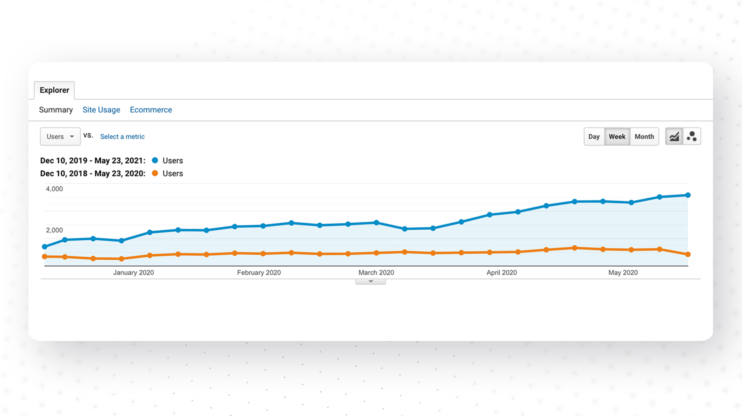
With the help of right WordPress SEO practices such as keyword researching, link-building, content optimization, and many other things we’ve had an overall 245% organic traffic growth within only one year!
And you can get the same results and even better if you follow our WordPress SEO guide.
20 fatal tips to achieve high rankings in 2021
Let’s start with the following:
WordPress SEO Basics
1) www vs non-www domain
When surfing on the web, you’ve probably noticed that websites either start with a “www” or are “naked,” meaning that they choose a non-www domain.
That’s one of the first questions you’ll face when starting your own website: Should I choose a www or a non-www domain? Does this choice influence my WordPress SEO in any way? We’ll help you to figure out.
So, here we go:
Www domains were famous back in the old days of the Internet when “www” served as a separate subdomain. It was also used on posters and other places to signify that the “example.com” is not just a random phrase on the edge of the poster, but has something to do with the “World Wide Web.” We’ve come a long way since then, and now people recognize the famous domain names without necessarily seeing the “www” sign.
As more and more people started searching for websites without actually typing the www domain name, many web pages decided that they would get rid of the www and that’s how the non-www or naked domain trend took over.
Although this brief history is quite engaging, you might still wonder what the actual difference between the two is nowadays? Www and non-www domains have different cookie policies, but in general, their functionalities don’t differ much, so you can pretty much choose whichever you like.
What about WordPress SEO?
The same goes for your WordPress SEO. Choosing a www or non-www domain is entirely up to you. Just make sure that your visitors can’t reach your website by both the www and the non-www domain. If you have both domains (www.example.com and example.com) working, then Google will perceive it as two different websites. And you certainly don’t want this to happen, because search engines will start skimming through both of them.
Plus,
if you have started with a www domain and now want to switch into the non-www one, then don’t forget to redirect all your pages accordingly.
2) Choosing a reliable hosting provider
If you want to get the most out of your WordPress SEO practices you also need to make sure that your hosting has all the required features. Even if you follow SEO best practices, if your website is too slow or not secure enough for your customers, you can be sure that search engines will not let you reach top rankings.
Moreover, Google and other search engines pay a lot of attention to user experience and for them, their customers are a priority. Hence, if a visitor leaves the page too fast because of a bad experience, this will also push you further down in the search results.
Good hosting providers not only help you manage your website easily and without any hassle, but they also assure you that none of this happens. Plus, some good hostings also give you a bunch of useful SEO tools to track your website’s SEO.
So, here is what you need to check with your hosting provider to avoid this type of situations:
- Speed

In this fast-moving world where we have high-speed trains, fast-food chains, absolutely everything is focused on saving time, you can be sure that even three seconds of loading time is too much for your visitor to stay on your website. And guess what happens if you’re too slow. You rank lower in search engines because you’ve made your customers wait.
According to Trinity, the statistics of the year 2019 have shown just how important speed can be in keeping your customers. Their data shows that even a one-second delay can result in a 7% drop in conversions.
Hosting plays a huge role in your website’s speed. If you’re choosing shared hosting then your website is going to be slow, because you share your server with hundreds of other users, while in the case of automated hosting, a managed hosting version of higher rank, you get a higher level of speed.
By the way,
if you want to check out your website’s PageSpeed score, you can try our WordPress Speed Optimization tool and get recommendations on how to improve your performance. If you score somewhere below 90, you have the option to sign up at 10Web. We’ll provide an optimized copy of your website with a 90+ PageSpeed score! Here is the preview of our tool: all you have to do is enter your website’s URL and check how fast your page is with the help of our speed optimization service!
See How 10Web Can Benefit You
Visit our homepage to learn more about the ultimate AI-powered website builder.
See How 10Web Can Benefit You
Visit our homepage to learn more about the ultimate AI-powered website builder.

Also, if you’re still not sure whether achieving high speed is indispensable or not, here is a detailed explanation of why exactly your website needs a 90+ Google PageSpeed score.
- Uptime
Uptime is also a must for your WordPress SEO. It shows the percentage of time that your website is up and running, i.e. accessible online to visitors.
If your website is down, then your users will go back to search engines, signaling to them that there’s something wrong with your page. Hence, Google and other search engines will not be showing your website on their result pages.
Moreover, the more popular your website gets and the more visitors it has, the more often Google will crawl through your page. And if it finds your website down more than once, it will remove you from its index. (the database where every website is stored)
Again, with shared hosting, it is very probable that your website can accidentally run low, because of your neighbors who are having too much traffic or security issues. In that case, all your hard WordPress SEO work will be gone. So, be sure you make the right choice with your hosting provider.
- Server Location
If uptime shows how often your page is accessible, then the server location plays a role in how fast it is accessible.
So, if you want your page to be available very fast then your data center should be as close as possible to your potential visitors. The logic is simple: The further your server is from the end-user the longer it will take your page to load. Many hostings have their data centers in different locations, but some also have all data centers based only in the US, which means if you target European audiences (or pretty much any other region) your site will work slower for them.
So, which hosting works best?
Now that we’ve mentioned all of the important hosting features for your WordPress SEO, we’ll also share with you our list of best hosting providers that have it all!
10Web

10Web provides automated WordPress hosting powered by Google Cloud that assures your website speed, uptime and excellent performance. Its Speed Optimization service guarantees that you’ll get a 90+ PageSpeed score (average websites are stuck with a 70 score, just for comparison) so that you can beat all your competitors. As mentioned, it is powered by Google Cloud and has 8 data centers located on 4 different continents, so your visitors can be from anywhere in the world! Not to mention that with 10Web’s automated hosting you can be sure that your website will not experience any downtime.
Plus,
10Web also has some additional features, such as a speed optimization service, an image optimizer, SEO by 10Web, etc. which come in handy for your WordPress SEO.
- Backups
Although it doesn’t directly influence your search rankings, automatic backups secure a version of your website in case the worst happens. You really don’t want to start building your website from scratch and do all the WordPress SEO work again! 10Web gives you the chance to decide how often you want to backup your website and this service is included in your package. You don’t have to pay additional costs, which is the case for so many other hosting providers.
- SSL certificates and security
Google has announced that security is their top priority. This is their statement:
“Beyond our own stuff, we’re also working to make the Internet safer more broadly. A big part of that is making sure that websites people access from Google are secure.”
So, having an SSL certificate and in general, making sure that your website is secure from the malicious attacks should be a top priority for you too. With 10Web you get a free SSL certificate along with security services which automatically update your plugins and take care of other technicalities in order to assure your visitors’ safety and hence improve your WordPress SEO.
- Customer Care
Finally, although this doesn’t impact your WordPress SEO directly either, it helps you with your website management in general. In case your page runs low, you’ll get super fast support. In case you don’t know how the plugin works, you’ll get an instant response. And in case you don’t figure out why something doesn’t work, you got it.
A good support team is always handy in website management, especially if you want to get rid of problems fast so that Google doesn’t remove you from its index, because of some technical issues.
So, in general, choosing a good host is extremely important for your WordPress SEO so make sure you pay enough attention to the features your hosting provider offers to maximize your SEO results.
3) Install an SEO friendly template
Not only does a good SEO template give you a nice design and captivate your visitors, but it can also be potentially boosting your WordPress SEO. So here is what you should check with your WordPress template:
- Valid coding: Does your theme use up-to-date coding? Is it compatible with popular browsers or not? You need to also make sure that it is working properly with mobile devices.
- Good speed: Speed, speed, and speed again. There is nothing more important than a fast website that doesn’t take too much time to load. Make sure that your theme is originally loading fast. 10Web templates, for instance, are pre-optimized to ensure a 90+ PageSpeed score.
- Friendly with social media: Of course social media is not considered to be an SEO practice, but we all know how important it is for your website’s traffic. So, make sure that your theme integrates social media platforms and links your page to Facebook, Youtube, Linkedin, and etc.
And of course don’t forget that no matter what, your theme should be an “eye-candy” so that you instantly catch your customers and provide the best user experience. This will certainly pay off in terms of your WordPress SEO. There are a bunch of SEO friendly themes, so check them out and pick one for your website.
4) Add your site to Google Search Console
Google Search Console is a free SEO tool available out there which can help you create a Google-friendly website and improve your WordPress SEO practices. It solves many SEO issues, shows you your most popular posts,displays your rankings, and in general helps you improve your traffic.
But let’s discuss it in more detail: Which services does the Google Search Console offer?
As listed by the Google Support team, here are some of the important services that the Google Search Console provides you:
- Confirms that Google is crawling through your website and finding it;
- Troubleshoots indexing problems and request re-indexing for the new and updated content (indexing refers to the process of including websites into the large database to be shown in the search engine results);
- ProvidesGoogle Search traffic data;
- Gives you alerts in case of you have indexing issues,spams, or other problems;
- Shows you which websites are linking to your page.
So, make sure you’ll make the most out of this incredible and absolutely free SEO tool.
5) Add XML Sitemaps in WordPress
The purpose of XML Sitemap is to help search engines to navigate through your website easier. Here is what it essentially does:
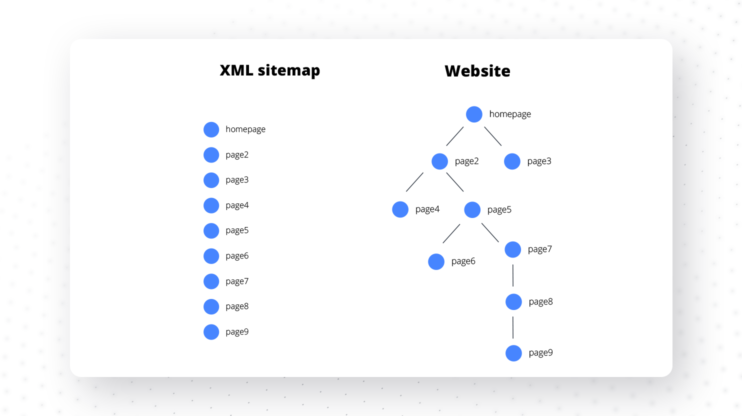
As you can see in the image above, if search engines scroll through your website, then they have to jump through different pages in order to get to the desired one. In the case of XML sitemap, everything is made clear and simple, and it is much easier for search engines to crawl through. Eventually, it leads to faster indexation and can be extremely important if you have:
- A big website with too many pages,
- Add new pages frequently.
- Are new in the WP business and don’t have many external links,
- Have issues with internal linking.
After you create the XML Sitemap for your WordPress either through the Yoast SEO plugin or the Google XML Sitemap plugin, make sure you double-check it and see if everything works correctly. Then, you’ll need to submit your XML Sitemap to Google Search Console. After this Google will automatically crawl through your sitemap when required. You can also submit your sitemap to Yandex and Bing search engines, because many of your competitors might skip them, giving you a better chance to rank higher in these engines and gain traffic.
6) Force Crawl
Before we jump into the force crawling tip, you might wonder how many of your websites have been actually indexed by Google. To do so just enter the following in Google Search site:example.com . The number you’ll get in the search results is the number of pages that have been indexed by Google. You can see it with our 10Web example that we have around 1.100.000 pages indexed.
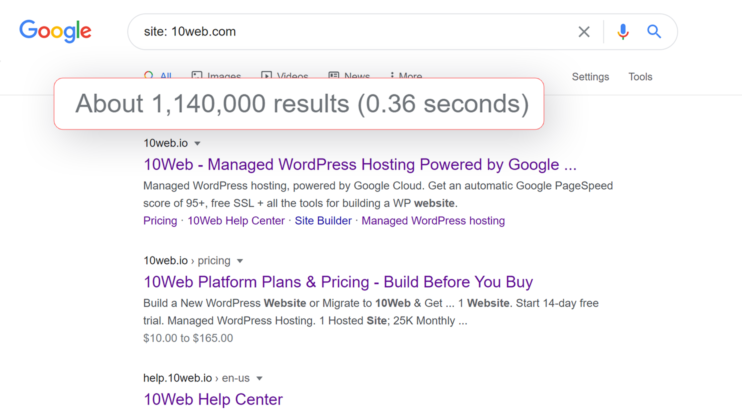
Moreover, if you want to check a specific URL, you can do the same using the site:example.com/web-page-slug operator. If you get zero results, then your website wasn’t indexed.
Now Google indexing, in general, can take from a few hours to a couple of days, so if you want Google to crawl through your website immediately you can force crawl it. This can help you beat your competitors, as your page would be analyzed faster. To do so, go to your Google Search Console and go to the URL Inspection section which is right under Overview. From here, enter the URL of the page that you want to be force crawled. You’ll get a message telling you that the URL is available on Google. Press the Request Indexing label below and you’re done!
Anyways,
you might see an error message if Google has a problem with accessing your website, so make sure you always check whether you have indexing errors, in order to be secure that your page can appear in the search results.
Now that we’ve covered the basics, let’s move on to the next item:
WordPress SEO plugins and services
Improving your WordPress SEO can easily become a headache if you start to do it completely by yourself. Luckily for you, there are a lot of SEO plugins and services that help you get rid of that hassle and minimize your work. In this post, however, we’ll mention only two of our favorites: Yoast SEO and 10Web.
7) Install the Yoast SEO plugin
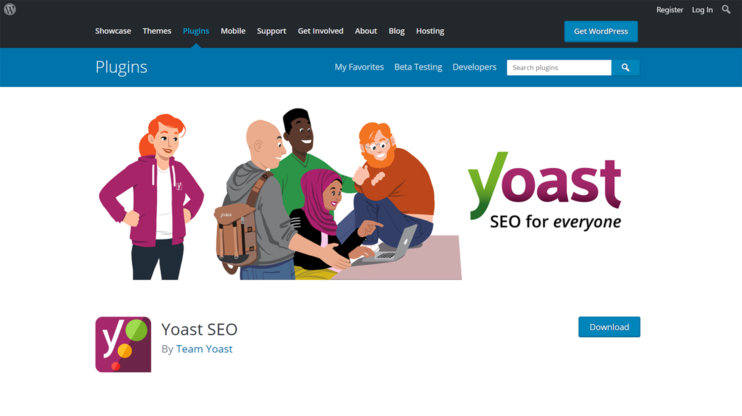
Let’s start with Yoast. If you’ve ever searched for SEO plugins or in general wondered how to improve your WordPress SEO, Yoast has certainly popped up in your search results. This is because Yoast SEO is one of the most popular WordPress SEO plugins. It allows you to:
- Increase your Google and Bing visitors,
- Attract more visitors from social media,
- Get more reader engagement.
But this is of course too general so let’s take a closer look at the Yoast SEO plugin.
Yoast has been in the market since 2008 and is very popular in the WordPress community as all of the essential SEO tools are available for free. Yoast SEO can be installed on any self-hosted WordPress from the WordPress Plugin directory. Once installed and activated, it will customize your website’s URL and meta tags, provide default SEO-friendly templates, allow you to modify the meta-titles and descriptions for the customized templates, check your keyword optimization and, in general, take care of your page’s searchability. In short, it is a sitewide SEO solution.
Plus,
Yoast SEO is also telling you how your page is doing in WordPress SEO by “grading” your page’s content. It’s pretty much like going back to school: You’ll get an “A” if you have all the focus keywords in the right places and you’ll get a “C” if your posts don’t pass Yoast’s criteria. This way, you know exactly what to work on.
So, if you want to try all of the amazing features (which you really should) install the Yoast SEO plugin, relax, and enjoy!
8) Use 10Web’s SEO services
Another amazing tool that you can use to improve your WordPress SEO is 10Web’s SEO service, a.k.a. SEO by 10Web. Now, we’ve mentioned 10Web already as a good hosting provider, but there’s way more to it. 10Web has a special SEO service that has a bunch of cool tools to help you rank high in search engines.
Here’s what you’ll get:
- Search analytics
10Web provides performance reviews for the desktop, mobile, and tablet versions of your website. With these analytics, you can find out which of your keywords helped you appear in searches, how many impressions you got, and your CTR. You can also filter this information by country name, website name, or date allowing you to see more clearly when and where your traffic was coming from.
- Redirects
If you don’t want your SEO to suffer, then you have to redirect your pages in case you make any changes to their URLs. For that, 10Web has a special section devoted to redirects. Here you can see the list of your redirects along with their types, the date of creation, and the number of times they have been redirected. You can also easily add a new redirect from here.
- Meta Information
You also get a special section where you can control and write your metadata. Plus, you can control the indexing of your pages by setting Meta Robots which index, deindex, follow, and unfollow for you.
In addition,
10Web WordPress SEO services also provide automatic XML Sitemap generation, knowledge graph management, 404 monitoring, and many other important tools that will improve your rankings.
Along with these basics, you also get bonus services which are the speed optimization service that we’ve already mentioned and the image optimizer. Now we’ll go over the last one quickly.
- Image Optimizer
Basically, this tool helps you resize, optimize, and compress the PDF, PNG, JPG, and GIF files, while still maintaining high quality. Yup, you heard it right! You’re going to have the high-quality images and GIFs, without them taking an eternity to load. Plus, you’ll be saving a lot of storage and bandwidth.
If all of this sounds super cool to you, it’s because it is. So, we totally recommend you to install and use SEO by 10Web and try all the amazing tools by yourself!
Now, as we’ve mentioned the helpful plugins that can do a lot of WordPress SEO work for you, it’s time to look into SEO best practices that you still need to know if you want to become the ultimate WordPress SEO guru. So, let’s jump right in:
WordPress SEO Best Practices
At this point you already know how to make your website appear in search engines, now let’s understand what you should do to improve your rankings.
9) Keyword Research

This is by far one of the most important SEO rules that you need to practice. We all know that search engines pay a lot of attention to keywords because they function on computer algorithms, right? Which means that they have to find and calculate your rankings based on something. And that something is the keyword.
So, in order to use the correct keywords in your content, you need to understand what your target audience will be looking for. Keyword research will help you figure out who exactly your target audience is and what they are searching for. In a nutshell, it tells you:
- What people search for,
- How often they do it,
- What they expect to get (in which format they prefer the content).
Here is how you can do efficient keyword research for your website:
We’ll look at the process with an example:
Say you are managing a website where you want to sell your home-made eco-friendly organic cookies that are gluten-free, taste super delicious, and are way healthier than ordinary ones. Although your idea is super cool, you need to figure out how anyone (except from your friends and relatives) can end up visiting your website. So, you need to understand what they will write in the search section if they want to buy your super healthy cookies
For that, you need to go to the keyword research tools such as SEMRush, KWFinder, Uber Suggest. There you’ll write some of the keywords that are connected to your content and might rank high in SERPs. Say your results include the following keywords: “organic cookies,” “healthy lifestyle,” “healthy desserts;” “gluten-free food,” and so on. You enter those words in the keyword research tools, which then will show you their search volumes and competition, allowing you to decide whether you want to use them.
These tools can also show you the websites with high domain authority, against which you are inevitably going to compete. By the way, if your competitors’ domain authority is 40 out of 100 or even lower, then you have good luck, because ranking higher for those keywords will be easier! You’ll also get suggestions for similar keywords that you can use as alternatives.
After analyzing all this data you can figure out which phrase would work best for your page and include it in your content. The next step would be understanding how often this word should be used in the content. Although your keyword density should be somewhere between 1.5% and 2.5 %, you don’t want to do too much keyword stuffing.
Also, remember that it also needs to merge into your content organically, because Google and other search engines are paying attention, as we’ve said already many times, to their users first. So, you shouldn’t write content that is designed for robots only.
Don’t forget:
Although it seems logical to go after the keywords that have been searched the most, don’t forget that sometimes less is more. So, let’s say if your “gluten-free cinnamon cookie” has less search volume than “healthy snacks,” you could still use the first one and focus on a niche audience. Eventually, it might bring you more traffic than a popular keyword, in which case the competition would be too high for you to cut through.
Moreover,
don’t neglect other languages. Sometimes writing in a language other than English can help you perform better, as your market will be smaller and your competition won’t be that huge. Of course, this wouldn’t work if you are targeting English-speaking audiences specifically, but if you bake and sell your cookies in France, writing in English wouldn’t serve your purpose.
10) Internal Linking
Another thing that you want to practice is building internal links throughout your content. In case you don’t know, internal links refer to the links that come from your website. For instance, if I put the link of A Brief SEO guide from our 10Web blog in this article, it’s considered to be an internal link. And if I put our Outdated SEO Practices link, it would also be an internal link, because it comes from the same website. And if I—okay, just kidding, you got the point. And yes, just now I was practicing internal linking myself because it’s extremely good for our SEO, and here’s why.
There are certain pages on your website that have more link value, or as it is called link juice, than others. Typically, your homepage is the one that has the greatest link value because it also has the most backlinks. Now any link to your homepage will share this link juice, so if you want your newest post to be found easier and have more value, then you can link them to your homepage!
The good part in all of this is that as a site owner you have control over your content so you can practice internal linking to give your most important blogs or articles more value for Google. With internal links, you also help Google to figure out the relationship between various pages and posts on your website and make Google understand which pages are covering a similar topic.
In short, make sure that you practice your internal linking properly because it’s an efficient SEO tool that’s entirely under your control.
11) External Linking
Yes, internal linking is important, but it doesn’t mean external links are not as or even more helpful for your website.
Google uses links to discover content and to rank that content. So, if your page has been linked to a lot of high authority domains, then Google understands that there must be something important in the article if everyone’s mentioning it. Hence, the more external links you have, the higher your ranking.
But before we dig deeper, let’s understand what external links are.
External links are divided into two types:
- Inbound links or backlinks: These are the ones that we were speaking of: the links from other websites to yours;
- Outbound links: This is when you put a link to another website on your page.
So, let’s start with inbound links. If your website receives links from authority websites and blogs, then Google will see it as a good sign. As we’ve mentioned, the more you get linked, and the more domain authority those websites who link to you have, the better you do in your search rankings.
Now, what about outbound links? Phylandocic will help us find out how they work. Don’t worry, we’ll explain to you what it is in a minute.
Including outbound links in your articles is also considered to be good practice. A recent study conducted by Reboot proves just that. Their hypothesis is that if you include outgoing links to reputable websites, Google is going to rank you higher, meaning that it will positively impact your SEO. To prove it, they’ve invented a new word “phylandocic” for an imaginary beauty salon that has never been searched before and created 10 websites with 300-word articles about this new salon. While all of these articles were similar in terms of their SEO (coding, keyword placement, and everything else was on the same level) 5 out of 10 contained 3 links to very high domain authority websites.
In the end, they confirmed their hypothesis, as the result showed that websites that were linked to authoritative pages had a better ranking, hence outbound links had their influence on SEO. So, next time you write content for your website spare a few links to other websites in order to boost your rankings.
By the way,
if you want to check how much domain ranking a website has, you can use Ahrefs’ Website “Authority” Checker. Remember, the more authority your website has the better it impacts your SEO when you link to it on your page. In general, a 70+ score is considered a high domain authority.
12) Taxonomy: proper use of categories and tags

Imagine you go to a library and there is no classification system. Fiction is next to medical studies, and here and there you can find random dictionaries. That’s a mess, right? The same goes for your website if you don’t use proper taxonomy. So, what is taxonomy?
Taxonomy is basically the system you use to classify your website and make it more organized. It makes it easier for your users to navigate through your website and to find similar content in the same place. This is done by adding tags and categories to your content. Let’s start with tags and tag archives.
Assume you are the owner of a famous film blog and you’re writing an article about Martin Scorsese. But this is certainly not the first or last article in which you’ll be discussing Scorsese’s cinematic genius. So, what do you do? You add a #Scorsese tag with which your readers can go to the tag archive where you’ll find every article that’s somehow connected to Scorsese. This is very handy for both users and search engines to understand how posts are connected to each other.
However,
you don’t want to overdo this either. Let’s say you’re writing a review on Scorsese’s “Taxi Driver” and you add a separate tag #taxidriver. Not only can this be useless but it could also be harmful to your website if there are no or very few other posts that discuss the film and use that tag. That way you won’t help your users find related posts, and you’ll also create dozens of archived pages that will confuse search engines and prevent them from figuring out what your site is about. So, although having tags is a must you shouldn’t put too many of those, as it will damage your WordPress SEO.
Other than tags you should also use categories.
Categories are the larger sections where every included article or blog is about that specific thing. So, let’s again take our film blog as a case in point. Your Scorsese article would for instance fall under the “American classics” category, where you could have other directors too, all of which would be American, and all would be considered classics. Let’s take a look at our 10Web blog.
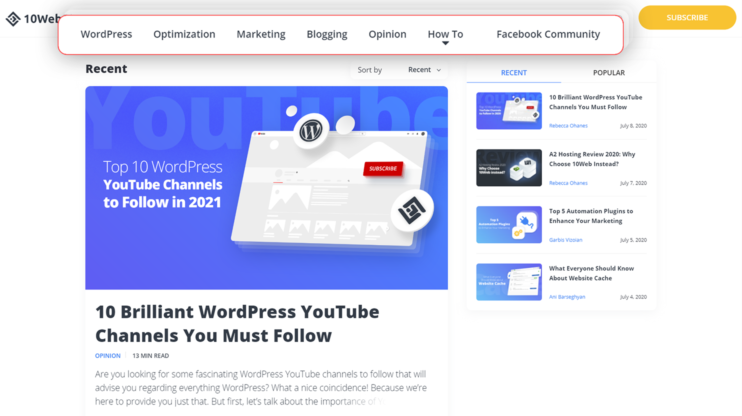
As you can see, in the upper section of our website right next to the 10Web Blog logo we have our categories: WordPress, Optimization, Marketing, etc. This means that you, as a visitor, can figure out what type of content you want to read and find it under the specific category. So, if you’re more of a WordPress lover, you’d go to our WordPress section where all our blogs are about WP, whereas if you’re already a 10Webber and you want to figure out how our 10Web SEO service works, for instance, you’d go to our How To category.
The same is true for Google. Once on your website, your categories will help Google understand which post is tackling what and what the main themes are that you’re covering. Again, just like tags, you don’t want to create too many categories, because that will mean that you’re covering each of them only superficially and that would be a bad signal for search engines.
13) Title Tags and Meta Descriptions
Next in our list of WordPress SEO tips is adding title tags and meta descriptions. If you’re hearing these terms for the first time, here is a short explanation of what they mean:
- Title tags: A title tag is an HTML element that specifies the title of your web page. In other words, these are the titles you see on the search engine results pages (SERPs).
- Meta descriptions: The meta description is the brief summary of your page usually below the title tag and, again, mainly displayed on SERPs.
To be more clear, let’s look at it using this example: If you write title tags in Google you’ll probably come up with Moz.com’s article and here is how you’ll see it on the first page of your Google results:

The “Title Tags-2021 SEO Best Practices- Moz” is the title tag of their page while the brief description right below is the meta description. Even if you didn’t know how they were termed you’ve seen title tags and meta descriptions thousands of times already, so you should be familiar with them. But how do they affect your SEO?
Let’s start with Title Tags.
Well, it might seem that these short lines can’t change too much, but in fact, they are absolutely crucial, as they are one of the main tools with which search engines understand what your content is about. This is also the first thing that your customer is going to notice. So if they are not informative and look absolutely boring, you’ll lose potential visitors. Other than appearing on SERPs, title tags are also visible on the web browsers (the title of the tab on top of your browser) and social networks. So, how to write a good title tag?
-
- <li
>Don’t make it too lengthy:
- Although there is no penalty for long titles, it is generally recommended to keep your title tag under 60 characters, as you don’t want your title to get cut off. Also, don’t forget that some letters such as capital “W” take more place than the others like non-capital “l.” So, you should also keep in mind how long your titles are in pixels (maximum 600 px) so that they are also short visually not only character-wise.
- Put important keywords first: Practice has shown that people usually read only the first two or three words of your title tags, so you want to put the most juicy ones first.
- Don’t overuse keywords: You can use keywords, but don’t try to put all the keywords in your short title tags. Not only will that look unnatural, but it will also worsen your SEO instead of improving it.
And in general, keep your customer in mind while writing your title tags. Ask yourself this: If you were in their place, would that title allure you? Would you click on the website’s link to see more? This will certainly help you come up with a good title. Now, let’s move to
Meta Descriptions
You might have heard that meta descriptions are no longer important for SEO. And yes, that’s true. Many SEO blogs have already mentioned that meta descriptions are not used in SEO rankings. However, that doesn’t mean that they are less important for improving your click-through rates. It gives you the opportunity to explain to your customers very briefly what the page is about (and title tags are too short for it). So take our meta description writing recommendations as a bonus in our WordPress SEO guide.
- Use the right length: The optimal length for your meta descriptions is somewhere between 50-160 characters, although this might vary depending on your content. Your meta descriptions can be a short summary of your page, but they also can be simply the hook that can instantly grab your visitors’ attention.
- Create unique ones for each post: In fact, you can skip meta descriptions and let search engines create them for you, but if you decide to write your own, be sure that you don’t duplicate them.
- Use an active voice and call to action: Make your meta descriptions actionable, call for your visitors to do something!
Back to our gluten-free cookies: In that case, your meta-description would be something like: “Get yourself healthy and delicious cookies… “ or “Get healthy with our gluten-free cookies…”. In short, telling your visitors to do something makes your descriptions more compelling
That said, you don’t always have to write meta descriptions, as sometimes search engines actually generate really good ones. But if you want to keep everything under control, then writing your own meta description is a good alternative.
14) Schema Markup
Moving on to schema markup. As usual, let’s first understand what it is. To do that you need to know what a snippet is. Well, we’ve discussed that your meta description is a short summary of your content. But say you want to see who your cookie-making website competitors are so you enter “gluten-free cookies” in Google search. You’ll get something like this:
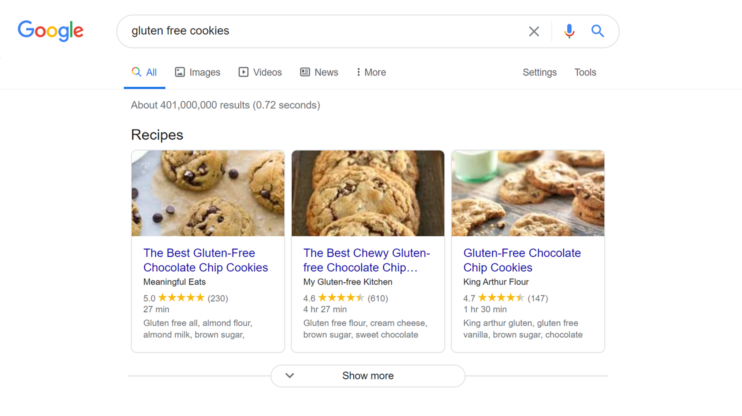
See the ratings down there? Plus each of these websites has a picture below their title tag. Well, this is not merely a description, but rather a snippet of their page. You’ll probably want to click on one of these results rather than the ones that have no ratings or pictures. And you can add other features in your snippets too, it doesn’t have to be limited to the mentioned ones. That’s why the next tip in our WordPress SEO guide is creating snippets. And here’s exactly where Schema markup comes in handy.
Schema markup is sort of the language of search engines. It is basically a code that is used to explain more clearly to search engines what your content is about. On the other hand, it also helps you create richer snippets such as the ones mentioned above that are more attractive to your users.
Do you remember that we’ve mentioned that WordPress is super SEO-friendly? Well, here’s one more proof why. Many WordPress themes already have schema markup coded into them so you automatically benefit from it. But in case they don’t, there are also easy to install schema markup plugins that you can use.
Similar to schema markup, there is also social markup. These are used to generate thumbnails on Facebook, Twitter, and other large social media platforms. Again, some of the SEO plugins, such as Yoast, provide the tools necessary to create your social markup. Of course, it is not proven that it boosts your WordPress SEO, but it certainly won’t do any damage to it either. Plus, with social markups, you’ll improve your SMM.
15) Get into the Google Knowledge Graph
Now, this is the ultimate level upgrade. Have you ever seen the box that pops up on Google search results? Here’s an example.
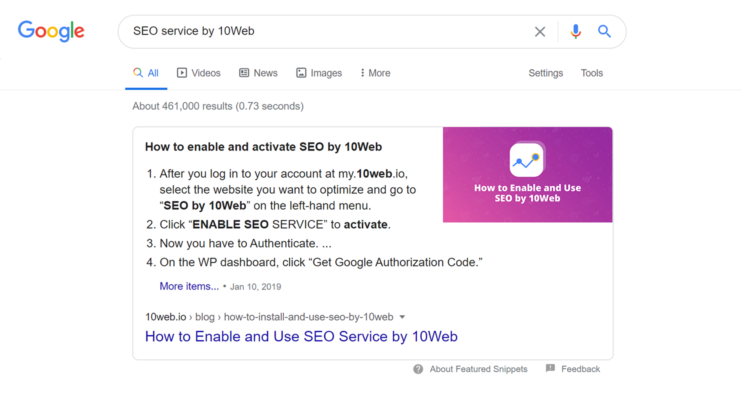
As you can see, once someone types SEO service by 10Web he or she gets this little box that tells them how to enable and activate our service. And they can get the main information without even tapping on our webpage. If you manage to get one of your posts displayed in this box this will skyrocket your organic traffic. But how can you do it?
Although, there is no definite recipe for that, there are certain practices that can eventually get you there. Use schema markup, include headers in your posts and write in bullet lists. And one day you’ll end up in this knowledge graph without even expecting it! Here’s a more detailed guide on how to make it to the knowledge graph or the so-called featured snippet.
16) WordPress Comments
Google loves lengthy articles and pages, so the more content you have on your page the better it is for your website. Having comments below your blog posts or articles is the easiest way to add word count and engagement to your page. That’s why do us a favor and let us know what you think of this article in the comments section. So, if a post is 3000 words long, then your visitors could potentially add 1000 more in your comments section if they get engaged in the quality of information. But to get there, you need to build a community that would lead insightful conversations in your comments, and you yourself should be constantly engaged by replying to those comments and deleting the poor-quality or spam ones.
Plus,
your comments section helps you get more LSI (latent semantic indexes) keywords. These are the keywords that are in a way a synonym to your main keyword. So let’s say you write an article on how to stay healthy for your diet cookies website and someone writes in the comments “Thanks, these tips will help me to stay fit!” Voila! “Stay fit” is your LSI, that you probably didn’t use in your blog, but that will start to be ranked, because of that amazing visitor who left a comment.
Now the default WordPress comment section is in fact very SEO friendly and comes absolutely free! But in case you want more, you can always get those comment plugins in WordPress to have a more customized look and additional features.
17) Have a blog section
Of course, this sounds ridiculous for you if your website is a blog, but here we’re talking about the ones who create websites for other purposes. If you have an eCommerce site, for instance, you might not think that blogging would in any way help your page. But with all tips that we’ve already mentioned, you can probably sense that you were wrong: Blogging is an easy way to create high-quality content targeting all of your desired keywords while advertising your products along the way.
If you write “How to live healthy” or “Alternative desserts in 2021” blog posts for your eCommerce website for selling cookies, this can help you bring visitors who could potentially become your customers. Plus, it would enhance your traffic. It goes without saying that your blogs should not be pure advertisements stuffed with too many keywords. Instead, you must genuinely write an article that you believe in, and which would really help your customers. Remember: users first, SEO algorithms second.
By the way,
having a YouTube channel can also improve your direct traffic, as it will create brand recognition. Direct traffic refers to any traffic that comes to your website via users directly typing your website’s URL on their browser. That means users already know your brand and they come directly to your page, i.e. you can cut your costs on ads!
Now, here’s also a little extra tip for you. Below is our graph showing that we’ve had a 129.55 % growth of direct traffic in a year. We connect this growth with the opening of our YouTube channel.
Here’s our graph:
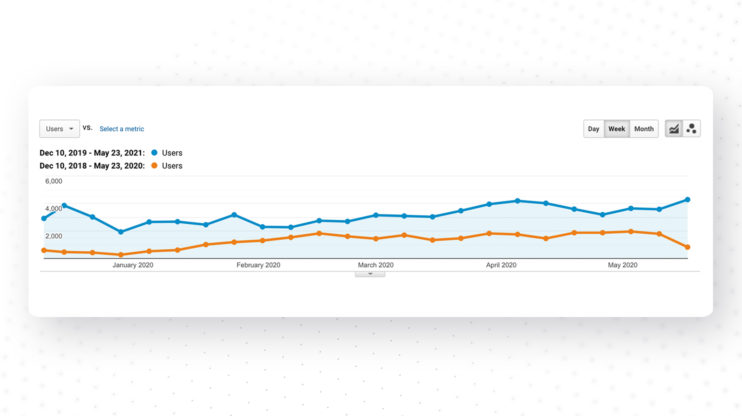
Although technically YouTube is not considered to be an SEO tool, our 10Web channel helped us raise brand awareness. With the help of our videos more and more people started to type 10Web’s URL in their browsers. Plus, incorporating YouTube videos in your blog posts keeps your visitors on your webpage for a longer period of time, which is a good signal to search engines.
Another tip that can help you grow bigger is keeping a blog section on your website. Of course, if you’re a blogger then this is going to sound ridiculous to you, but if your website has a different purpose, then it will help to have a content-related blog section to grow your traffic.
So, if you eventually decide to keep a blog, here is what you should keep in mind:
- You need to be active: You might start with a lot of enthusiasm, but if you don’t keep it up, your blog will not be of any use. If you’re going to post once in a month, then you can forget about getting on top of SERPs. You need to always remain active and post a couple of blogs a week. With this, you’ll also develop a devoted community that will wait for your posts and will actually be engaged with your blog. Just remember how important it is for the comments section. By the way, according to Sweor, your content should have at least 2000+ words to stand a chance against your competitors.
- Make it visually appealing: Now this is true for anything on your website, including your blog posts. You don’t want to make your readers bored, and you certainly don’t want to lose them, because your website looks old-fashioned. In order to keep your visitors on the page, include some pictures, videos, GIFs and divide your text into smaller sections. Because endless texts can scare off your customers.
- Update your old posts: Google loves fresh content, but the truth is your updated articles might bring you even more traffic than the completely new ones. According to HubSpot, republishing your old posts by optimizing their content and images can increase your traffic by 106%. So, show Google that you’re always refreshing your articles by editing them according to current trends. Also, don’t forget that people see which date your article was published on in their search results, and chances are they will go for the one that is newer. But don’t worry, here’s a trick. If you just add a couple of sentences to your old post, it will show that it was just recently published , and this way you can always rank high in SERPs.
In addition to that, you can create a never-dying content. Let’s discuss it more thoroughly in our next WordPress SEO tip.
18) Create an evergreen content

Now, in case you’re not going to update your content regularly, create content that will never become outdated. This type of content is called evergreen content. So, if you have an eCommerce website, and you create a blog for a very specific product you offer, the day you stop selling it the blog post will be useless. This is what you should try to avoid. Plus, if you want your content to always be relevant try to make it more general. Don’t focus on specific events or dates.
But don’t get us wrong,
content that is very time-bound can also bring in a lot of traffic. For instance, you can build a post that tackles the COVID issue and tells people how to entertain themselves with your services during the lockdown. Of course, this might not be relevant a couple of years later, but it will still bring in a lot of traffic at a given moment. So, you don’t necessarily need to make all of your posts too general, just make sure you have a couple of good quality, evergreen posts that can be easily updated and endlessly shared. If you want a more thorough explanation of how to create evergreen content, here are a few tips you can follow:
Choose keywords with search volume
As we’ve already mentioned, you want to find keywords that people search for a lot. Usually, these will help you choose a topic, that isn’t too specific and can generate a lot of traffic. By the way, you can also check whether the keyword is bringing much traffic to the top-ranking pages and then decide whether you want to use it.
Check how the trend changes over time
Even if you find a good keyword for the evergreen content, you should make sure you get a positive trend over time. This means that your keyword should not be on the decline or just a seasonal trend. Not to mention that if you write a seasonal keyword, like “Halloween cookies,” it will instantly die off after Halloween. You can check it with Google Trends.
Pay attention to search intent
In case you’re not familiar with the term, search intent is the purpose of a search query. If the intent of your keyword is not clear, then you can get a lot of bouncing in your rankings.
19) Use Google Analytics
It goes without saying that you should take advantage of all the tools available out there, Google Analytics in particular. Many of its services are free, but if you want to get more out of it you need to pay. Here are just a few things you can do with it:
- See real-time traffic data,
- See where that traffic comes from,
- Track your campaigns,
- Understand what people search for on your website,
- Identify your top posts,
- Reveal which pages work the worst,
- See your data visualized, and much more.
Google Analytics is also helpful in finding out how you are doing on mobile devices. As you might have noticed, more and more people nowadays are accessing the World Wide Web via their smartphones, so mobile-friendliness is a must. If you want to try it, here’s how to add Google Analytics to your WordPress.
Moving on to our last but not least important section in our WordPress SEO tips.
Security for WordPress SEO
So far, we’ve mentioned how important it is that your hosting provider guarantees security, but let’s go over it more thoroughly.
Just think of it this way:
When you are searching for something on Google and tapping on the first link, you don’t even doubt that the page is secure. Most of us take security for granted. This is because Google has made its users’ security a priority even back in 2014 where Pierre Far announced that there should be “HTTPS everywhere” to ensure secure communication. Now let’s quickly go over the HTTP and HTTPS difference.
- HTTP (Hypertext Transfer Protocol) is an application protocol that allows to transfer data, or in other words to show and receive information.
- HTTPS (Secure Hypertext Transfer Protocol) has the same function asf HTTP but it provides an additional layer of security through the SSL (Secure Sockets Layer). The latter helps you securely give and receive important personal information, such as credit card details, passwords, and personal details.
In addition to that, it is also healthy for your SEO. So, our last tip is:
20) Using SSL/HTTPS for your WordPress SEO
In addition to making your webpage secure, an SSL will also give you better rankings.
You might not notice it immediately, but switching to HTTPS will certainly pay off in the long run. Google search algorithms are more and more embracing website security, so your SSL certificates’ advantages are not going to go away anytime soon. In addition, almost all SEO experts recommend incorporating SSL in your long-term SEO strategy. So, yes, it’s certainly worth switching to HTTPS if you haven’t done so yet.
In addition to obtaining an SSL certificate, don’t forget to secure your WordPress website by:
- Constantly updating your plugins: Old plugins can be an easy gateway to your website for hackers, so don’t forget to delete the ones that you no longer use and to frequently update the current ones.
- Using Strong Passwords: As you might have guessed, using a “password” for your WordPress password might not be the best idea. Hackers can easily break into your page if your password is too cliche. So, choose a very strong one that has symbols, numbers, and capital letters to avoid security threats.
- Backing up: We’ve said this many times before, but we’ll say it once more. Backup your website, because you never know what will happen and you certainly don’t want to wake up one morning understanding that you’ve lost all your hard work and have no backed-up version of your page.
So,
mind these tips and follow our WordPress SEO guide, and in a few months you’ll see how your rankings will start to boost, and you’ll be getting more and more website traffic! Yes, it can be hard work, but you’ll certainly thank yourself in the end. Here’s to seeing you next time at the top of Google search results!
FAQs
How effective are WordPress SEO services/plugins?
It depends on which ones you choose. Yoast has proven to be very helpful in SEO management, and 10Web’s SEO service also gives you a lot of important tools, such as image optimization, speed optimization, XML Sitemap generator, etc., to practice your WordPress SEO easily and get high results.
But don’t forget that using too many plugins can hurt your website. First of all, old plugins are one of the most popular tools hackers use to get access to your page. And if you have too many plugins, then it can be easy to forget to update them regularly, hence creating a security loophole on your website.
On top of this, many plugins will slow down your webpage and as we’ve already discussed, you want your website to be fast in order to rank high on SERPs. In short, it is best to use only a few good plugins, so be careful to choose the right ones.
Why is WordPress good for the SEO of your website?
Because its coding is initially SEO friendly. It is optimized for mobile users and it also has cool plugins that are designed specifically for SEO. WordPress makes a lot of SEO practices easy. You can manage your metadata in a simple way, easily optimize your images for SEO, integrate your social media, and get access to very SEO friendly themes. If you want to read more on that, here’s a good source.
What are the best free WordPress SEO plugins?
Well, we’ve mentioned SEO by 10Web and Yoast, which have all necessary tools to boost up your rankings. Anyways, if you want a couple more, then you can also try the All in One SEO Pack along with these amazing free SEO tools that would help you increase your traffic.
What is a slug in WordPress SEO?
Take a look at the link for our 10Web blog: https://10web.io/blog. You see the word “blog” at the end of our URL. That’s a slug. It helps you understand that you’re in the “blog” section of our website. So, slug is basically a part of the URL that identifies the particular page in a comprehensible manner.
Let’s take a more complex example:
https://10web.io/blog/category/speed/. This is the link of our blogs about web performance and page speed. In this case with the help of slugs, you can also see the entire path of the page: You go from blogs to categories, choose the Page Speed and then jump into the blogs. Slugs make this process easy to read.
Now why are they important for your WordPress SEO?
- You can include keywords in URLs: WordPress gives you the ability to edit your URLs which means that you can write your desired keywords in the form of slugs in there. This is a huge advantage for your SEO.
- Make URLs user-friendly: You have probably noticed the unintelligible symbols in URLs that make them look like a complete mess and scare off many potential customers. With slugs, you can avoid this problem. An article that has the URL example.com/seo-practices is more likely to catch your attention than the one that reads example.com/ ?P=67546.
In short, if you keep your slugs SEO friendly you can easily improve your searchability.
Are WordPress tags important for SEO?
As we’ve mentioned before, tags help you arrange your content. So, if someone comes to your blog and reads a blog post about let’s say #SEO, he or she can find similar posts under the same hashtag. Moreover, they help search engines understand which posts on your website are connected to each other. So, if I tag three of my posts under #SEO search engines, Google will realize that both of these posts go together and tackle the topic of SEO. Plus, tagging and applying categories also makes your website more structured and easy to navigate for both your users and search engines.
However,
just like with everything else, don’t overuse =tags by stuffing all your keywords in there. If you have only a couple of posts under one tag (let’s say 2-3) you will only create dozens of useless tag archives for each which will make your website a mess. Plus, it won’t really help your users to find blogs around very specific topics in one place if you put too many tags under each blog making them appear in thousands of tag archives.
In short, yes, tags are good for your WordPress SEO, but not when you overdo them.
Are WordPress themes SEO friendly?
Choosing the right theme is important because if the theme is well coded and doesn’t have too many JavaScript or CSS codes, then it will be faster to load. Fortunately, WordPress imposes very strict standards for coding so most of the default themes you’ll get with WordPress are very SEO friendly. However, this doesn’t mean that all themes are necessarily coded well enough, since some may not be updated.
So, how can you check whether a WordPress theme keeps the latest coding standards?
You could simply trust the theme’s popularity. If the theme has over thousands of downloads and a good rating, then it’s worth going with it, as others have already tested it for you. In addition, you can check your theme’s coding with the Theme Check plugin that will scan over your WordPress theme and give you feedback on the quality of its coding.
Finally, your theme should also be updated to keep up with security standards, so you should also check its updating frequency by looking at the changelog of the theme. If the theme is not being updated regularly, then it’s better for you to skip it.
By the way,
10Web’s templates follow high standards and are SEO friendly which makes them a very quick and easy solution. With these templates, you will not only automatically boost your SEO, but will also get a beautifully designed website that will give your users the best experience and will keep them engaged.
What is the SEO title in WordPress?
If you want to find the HTML title tag, then you can right-click on the page, choose the “View Page Source” option, and you’ll be directed to a larger coding page where somewhere, in the beginning, you should find the page’s HTML title tag. This is also called page title or SEO title.
You see this title when you search for something on Google or other search engines. It will appear in your SERPs along with the website’ URL and meta description (and sometimes pictures, ratings, etc.). Now it’s important not to confuse the SEO title with the page’s heading, which is the main heading that you’ll see once you actually click on the page link. So, basically it is the very first thing your users will see: SEO title should attract them even before they actually go to your webpage.
Why is it important?
SEO titles can help you rank for your desired keyword and should be captivating enough to catch the searchers’ attention. How to do that? Make sure your title has the right width (maximum 600 px) to not get cut off in the search results and use a title that you yourself would click on.
If you want to get a higher ranking on search engines and beat your competitors, then follow these 20 tips on how to improve your WordPress SEO in 2021, and you’ll without a doubt boost your rankings. In this blog post, we’ve covered WordPress SEO basics, best WordPress SEO plugins and services you’ll need, the absolute “must-do” SEO practices, and security guides to keep your website safe.







Thanks for the detailed article on WordPress SEO. All of these tips are definitely interesting and helpful, especially for those new to SEO. I think that keyword research, among other things, is the basis for a successful SEO strategy.
Agreed! Thanks for your feedback, Anna 🙂
Hi Mari,
Thanks for sharing your views
practical, informative, and detailed
thanks for great content
Thanks a lot ! I’m glad you liked it 🙂